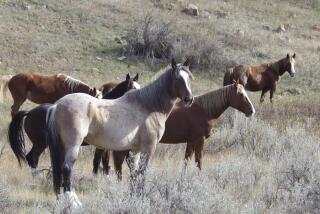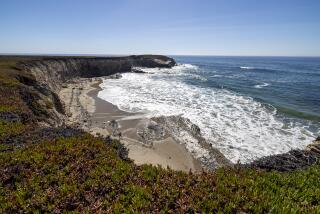A Curious Commemoration
- Share via
The U.S. Fish and Wildlife Service is proudly celebrating the 100th anniversary of the national wildlife refuge system, which it manages. Theodore Roosevelt created the first refuge, Pelican Island in Florida, 100 years ago this month to save brown pelicans from hunters who gunned them down for their feathers. The system’s 575 refuges today cover 95 million acres and shelter everything from tropical fish to polar bears.
The service is marking the occasion by “showcasing and strengthening the entire agency’s programs.” It’s curious then that the service’s ultimate boss, Secretary of the Interior Gale A. Norton, should have asked Congress last week to subject one of the nation’s most celebrated refuges to oil and gas exploration and production. Even more curious, Norton painted the Arctic National Wildlife Refuge on Alaska’s North Slope as a barren, uninviting place where it would scarcely matter if some tundra was torn up.
Showing House members a slide, Norton said, “This image of flat, white nothingness is what you would see the majority of the year.” Never mind that the refuge often teems with birds, fish and wildlife, including the Porcupine caribou herd, polar bears and wolves. Environmentalists call the refuge America’s Serengeti because of the richness of its wildlife.
The decision may hang by a single vote. Democratic Sens. Blanche Lambert Lincoln and Mark Pryor, both of Arkansas, Sen. Gordon Smith (R-Ore.) and Sen. Norm Coleman (R-Minn.) are being heavily lobbied to abandon the fragile majority opposed to drilling.
Norton’s appeal Wednesday was that Alaska’s Arctic coastal plain (she mostly avoided referring to it as a refuge) could produce more oil than any state. That may sound impressive, but the nation could save more oil, and sooner, by raising fuel-economy standards by a few miles per gallon.
Norton said oil companies would be required to use new technology and to drill with little or no damage to the tundra. She did not add that if oil was found, the wells would be linked by collection pipelines that must be maintained in summer and winter. This industrial support infrastructure is what most mars the landscape and creates a hostile environment for wildlife.
The Fish and Wildlife Service makes a compelling case on its own Web site for keeping the refuge as it is: “The Arctic refuge is among the most complete, pristine and undisturbed ecosystems on Earth ... a combination of habitats, climate and geography unmatched by any other northern conservation area .... “ The refuge will no longer be complete, pristine or undisturbed if President Bush and Norton have their way.
More to Read
Sign up for Essential California
The most important California stories and recommendations in your inbox every morning.
You may occasionally receive promotional content from the Los Angeles Times.













